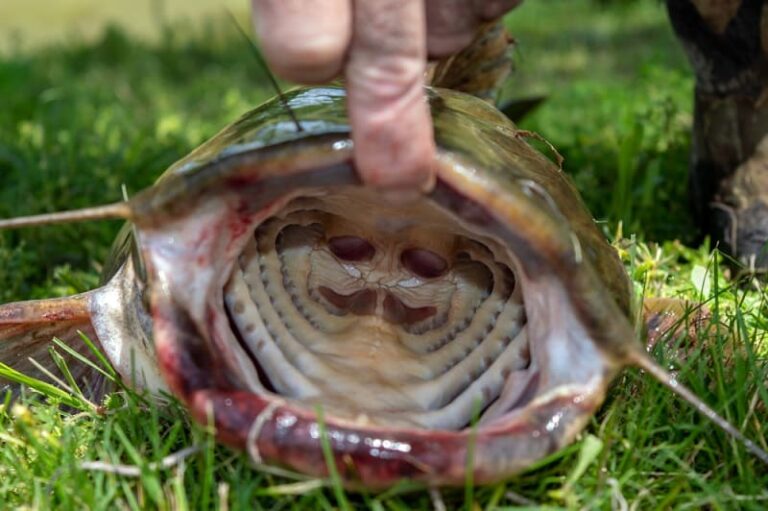How to Catch Catfish with Chicken Liver

Found at your local grocery store, chicken liver is one of the best baits for catfish. The bloody, stinky, juicy liver is a delicacy for hungry catfish.
Chicken liver is a bit tricky to use and comes with unique challenges, but once you know how to catch catfish with chicken liver, you will have lots of success on the water.
Is Chicken Liver Good Bait for Catfish?
Yes, chicken liver is a great catfish bait for two main reasons. First, is is very bloody and smelly.
Catfish find food primarily by smell, so the more scent a bait has, the better. It can be a bit annoying to handle the chicken liver because you are sure to get your hand covered in blood, but it is worth it.
Second, chicken liver is very accessible. Things like cut bait, live bait, dough bait, and many other commercial catfish baits are hard to come by.
You either need to catch them yourself or go to a bait shop and spend lots of money for them. However, chicken livers can easily be found at any local grocery store.
Which Catfish Does Chicken Liver Catch?
Chicken liver can catch all species of catfish, but it seems to have the most success when fishing for channel catfish.
In fact, I only ever use chicken liver when I am fishing for channel catfish. I have caught blue catfish and flatheads on chicken liver, but I don’t seem to catch as many.
If I am fishing for blues or flathead, I will stick to natural cut bait 100% of the time. Channel catfish are less picky about what they eat.
As long as they can smell it and it tastes decent, they will gobble it up.
Also read: Bank Fishing for Catfish at Night
How to Keep Chicken Liver on the Hook
This is the biggest problem with chicken liver. They are very soft and heavy.
Hooks will tear right through the liver while casting or when the bait hits the water. And you can’t catch any catfish if your bait isn’t on the hook.
I actually don’t use chicken liver very much for this very reason. But there are ways to keep chicken liver on the hook.
Mesh or Pantyhose:
-
- Cut a small piece of mesh material or an old pantyhose.
- Place the chicken liver chunk in the center of the material.
- Wrap the material around the liver and hook, securing it with a rubber band or thread.
- The mesh or pantyhose acts as a barrier, preventing the liver from easily falling off.
Bait Thread:
-
- Use bait thread (often available in fishing stores) to tie the chicken liver firmly to the hook.
- Wrap the thread around the liver multiple times, ensuring it is secure.
- Trim any excess thread to prevent it from interfering with your cast.
Treble Hook:
-
- Consider using a treble hook, which has multiple barbed points.
- Insert the chicken liver onto the treble hook so that it covers all the points.
- This helps keep the liver in place and provides better hooking potential.
- I never do this because I always use circle hooks when I am catfishing.
Sock It:
-
- Cut a small piece of thin cloth or sock.
- Place the chicken liver on the hook, then wrap the cloth or sock around it.
- Secure the cloth in place with a rubber band or thread.
- The cloth will hold the liver in position while allowing scent and flavor to disperse.
Freeze It:
-
- Partially freeze the chicken liver before using it as bait.
- This makes it firmer and less likely to fall apart when casting or while in the water.
- It can also slow down the rate at which it disintegrates in the water.
- This isn’t ideal because frozen chicken liver has much less smell and makes the bait less effective.
Elastic Thread:
-
- Wrap an elastic thread tightly around the chicken liver and hook.
- The elastic thread will provide extra security and help keep the liver in place.
Bait Bands:
-
- Bait bands are small rubber bands designed to hold soft baits like chicken liver.
- Slide a bait band over the liver and then attach the liver to the hook.
- When cast, the band will keep the liver secure until it’s in the water.
Fish in Ponds

Ponds are the perfect place to fish chicken liver. Rivers will tear up the soft liver and rip it straight off the hook.
Small ponds are brimming with channel catfish that will gobble up chicken liver.
Catfish in big lakes and reservoirs tend to be a bit smarter and more finicky about what they eat. They will target more natural things like cut or live bait.
Best Catfish Rig for Chicken Liver

This is nothing special and is the same rig I use no matter what bait I am fishing with. I always use the slip sinker rig.
Because the weight slides freely, the fish will never be able to feel the weight no matter how heavy a sinker you are using.
Some people use bobber rigs to suspend the bait in the water column, but I have never found this to work any better that the slip sinker rig.
This is just my personal view, but anytime I am catfishing, I will tie on the slip sinker rig.
Also read: Do Catfish Like Chicken?
Best Season to Use Chicken Liver
I have found that chicken liver works best in the summer and fall.
Channel catfish become very active in the summer and will seek out scents from far away.
The bloody taste of chicken liver gets these high-metabolism catfish drooling. The fall season is also a great time for chicken liver, especially the late fall.
In the late fall, these catfish are making one last push to eat as much as possible before the cold winter.
They seem to really hone in on the scent of blood during this time. If I don’t have any frozen cut bait, I will quickly run up to the store and get some chicken liver.
Chicken liver will work all year round, but I find that the summer and late fall are the best season to fish it.
How to Toughen Chicken Liver for Fishing
Chicken liver can be toughened by freezing it, sun-drying it, or salting it.
I never freeze my chicken liver because it reduces the smell and effectiveness of the liver and once it thaws out, it is just as soft and fragile as before.
Sun drying it can work well. It creates a kind of chicken liver jerky type of bait. This also reduces the blood and scent of the bait, so it is not ideal.
My favorite way to toughen chicken liver for fishing is to soak it in salt. Put the chicken liver in a bag of salt for a couple of days.
The salt will dissolve into the liver as well as drying it out a bit. This is a popular strategy for toughening up hot dogs, and it also works great for chicken liver.
The salt also adds some scent and flavor to the bait.
Key Points
- Choosing the Right Chicken Liver: Select fresh chicken liver for optimal results. It should be firm and free from any foul odors or discoloration.
- Preparation Techniques: Soak the chicken liver in a brine solution or marinate it in your favorite spices for enhanced flavor and durability on the hook.
- Selecting the Right Gear: Utilize appropriate fishing gear such as medium to heavy rods, strong fishing line, and sturdy hooks to handle the weight and strength of catfish.
- Effective Fishing Techniques: Employ bottom fishing or drift fishing methods in areas with known catfish populations. Ensure proper bait presentation and be patient for bites.
FAQ

Can I Use Frozen Chicken Liver?
While fresh chicken liver is generally preferred for its texture and scent, frozen liver can also be used.
However, thawed liver may not hold up as well on the hook compared to fresh liver.
What Size Hook Should I Use for Chicken Liver?
Use strong hooks in sizes ranging from 2/0 to 4/0 to effectively secure chicken liver bait.
Ensure the hook is sharp to improve hooksets and minimize missed strikes.
Are There Good Alternatives to Chicken Liver?
Yes, catfish are opportunistic feeders and can be enticed with various baits such as cut bait, stink bait, worms, or commercial catfish baits.
Experimentation with different baits can help determine what works best in your fishing location.
Conclusion
Chicken liver is a great catfish bait, but requires some special techniques to be effective. Keeping it on the hook is the biggest annoyance and draw back.
But, if you can hold it on the hook or toughen it up enough, it words great.
Chicken liver works best when pond fishing for channel catfish but can still catch all types of catfish in all water conditions.
I use it all the time because of how convenient and reliable it is.
Good luck!







